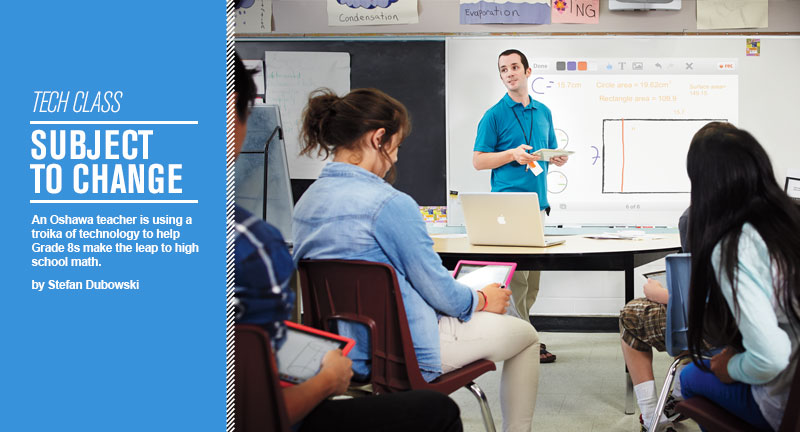
Andrew Godin, OCT, St. Thomas Aquinas Catholic School, Oshawa.
Challenge Help Grade 8 students make the challenging transition from elementary-level to
high school-level math.
Solution Give students iPads, a web whiteboard app (Educreations) and a social media app (Edmodo). Develop lessons that encourage students to investigate math solutions, collaborate on assignments and provide peer reviews.
Lessons learned Many students struggle with the transition to Grade 9 math. “They’re going from an environment where they were getting 80s to getting 60s,” says Andrew Godin, OCT, a teacher at St. Thomas Aquinas Catholic School in Oshawa. In Grade 9, students encounter new mathematical concepts, such as advanced algebra. To understand and succeed, students need to learn how to tackle novel math models.
Educators at St. Thomas Aquinas and Monsignor John Pereyma Catholic SS partnered in a Teacher Learning and Leadership Program (TLLP) pilot project, which funded the purchase of iPads for Grade 8 and 9 students. The teachers hoped that equipping students with the latest technology would help them engage with math curriculum.
For the Grade 8s, Godin set up access to Educreations (educreations.com), an online whiteboard service where students can arrange photos, create drawings and record their voices to explain how they developed solutions. Godin also gave students access to Edmodo (edmodo.com), a social networking site where they post their work and provide peer feedback.
These tools help interest students in the curriculum. The social networking and whiteboard software helps them communicate in new ways. “Many of them are amazing auditory learners, but they struggle with writing,” Godin says. “Still, they have the ideas.” Using audio and visual software like Educreations aids students in expressing their thoughts and developing their own ways of learning new concepts.
Godin believes technology has a significant impact on student engagement. He used to have trouble getting completed, (or even partially completed) assignments from them. Now, he receives completed assignments on time, and the quality is higher than ever before.
Observations Godin started collecting information that would help guide the project when the they were still in Grade 7. Most students thought iPads would be useful for Internet research. But once he introduced apps, they realized they could use technology to create visual representations of math solutions and share their work.
Godin says the project helped students understand that it’s OK to make mistakes, even for teachers. Case in point: for an English assignment, he recommended students use a poster-design app to create a newspaper page exploring themes in To Kill a Mockingbird. But the software didn’t have enough space for multiple lines of text and pictures. Admits Godin: “That one sort of blew up in my face.”
YOU CAN DO IT TOO!
You’ll need
- iPads, online whiteboard software, social networking software
Steps
- Partner up: elementary schools and high schools should develop this program together
- Learn best-tech practices: teachers at St. Thomas Aquinas and Monsignor John Pereyma attended a one-day iPad training session
- Create student accounts: these will be needed for a web whiteboard service such as Educreations and a social networking service like Edmodo
- Integrate technology into your lessons: have students complete assignments using the whiteboard service and peer review each others’ work through social networking
HELPFUL HINT
Worried that you’ll find the technology too difficult to learn? Relax. “The way technology is now, it’s very forgiving,” says Andrew Godin. “Still, don’t be afraid to have a bad lesson. At the least, you’ll learn what not to do.”
PHOTO: MATTHEW LITEPLO